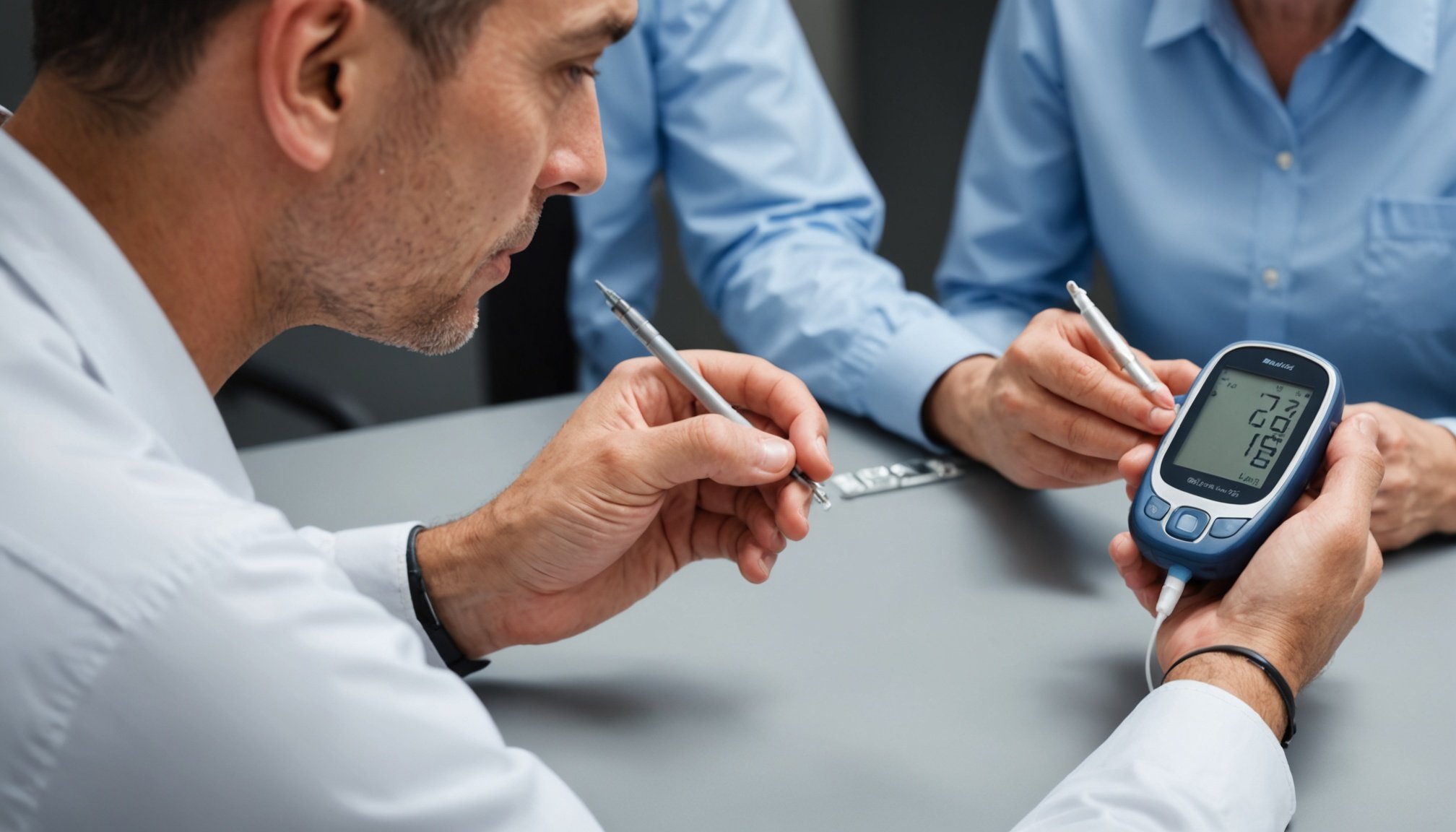Revolutionizing Diabetes Care: The Impact of Continuous Glucose Monitoring on Effective Management
Understanding Continuous Glucose Monitoring (CGM)
Continuous Glucose Monitoring (CGM) has been a game-changer in the management of diabetes, offering a more comprehensive and real-time approach to tracking glucose levels compared to traditional blood glucose monitoring. Here’s how it works and why it’s so effective.
CGM systems provide frequent glucose measurements in interstitial fluid, transmitting a continuous stream of real-time glucose data to patients’ smartphones or handheld readers. This data is displayed in numerical and graphical formats, showing the current glucose level, historical trends, and trend arrows indicating the direction and velocity of changing glucose levels[2].
In the same genre : Empowering Adolescents with Type 1 Diabetes: The Role of Customized Nutritional Counseling
The Benefits of CGM in Diabetes Management
The integration of CGM into diabetes care has numerous benefits, particularly in improving glycemic control and reducing diabetes-related complications.
Improved Glycemic Control
Studies have consistently shown that daily use of CGM improves overall glycemic control. For instance, a Diabetes Performance Improvement Program (DPIP) that included CGM, supported by diabetes self-management training and medical nutrition therapy, resulted in significant reductions in HbA1c levels. In one study, HbA1c levels dropped from 11.79% to 7.88% over just three months, with all subjects achieving HbA1c levels below 10%[2].
Also read : Exploring the Effects of Weighted Blankets on Sleep Quality for Adults with ADHD: A Comprehensive Guide
Reduced Diabetes-Related Events
CGM use has also been linked to a reduction in diabetes-related events such as hypoglycemic and hyperglycemic episodes. The real-time data provided by CGM allows for immediate interventions, preventing severe glucose imbalances. This proactive approach translates to fewer hospital stays and emergency room visits, which is particularly beneficial for underserved populations who may face financial strains due to these events[4].
Enhanced Patient Engagement
CGM enhances patients’ understanding of their diabetes and increases their engagement in daily self-management. The detailed insights provided by CGM help patients make informed decisions about their diet, exercise, and medication, leading to better overall management of their condition[2].
Key Components of Effective CGM Use
For CGM to be truly effective, several key components must be in place.
Interdisciplinary Care Teams
An interdisciplinary care team, including endocrinologists, certified diabetes educators, pharmacists, and supporting staff, is crucial. These teams provide comprehensive support, including diabetes self-management training (DSMT) and medical nutrition therapy (MNT), which are essential for maximizing the benefits of CGM[2].
Remote Patient Monitoring (RPM)
Remote patient monitoring (RPM) has revolutionized diabetes care by making it more convenient and accessible. CGM devices allow patients to share their glucose data remotely, enabling healthcare providers to review and analyze the data in real-time. This approach reduces the need for frequent in-person visits and allows for timely, data-driven decisions[4].
Integration with Electronic Health Records (EHRs)
For healthcare providers to get the most out of CGM insights, the data should be integrated within the patient’s EHR workflow. This integration allows providers to see the whole picture of the patient’s health, including metrics like time in range (TIR), days the sensor has been worn, and other relevant clinical information[4].
Factors Impacting Poor Glycemic Control and How CGM Addresses Them
Poor glycemic control is often due to several factors, and CGM addresses these in multiple ways.
Therapeutic Inertia
Therapeutic inertia, or the failure to intensify treatment when necessary, is a significant contributor to suboptimal diabetes management. CGM, as part of a structured program like DPIP, leverages the informational and psychological benefits of continuous glucose data to facilitate timely and appropriate treatment adjustments[2].
Lack of Real-Time Data
Traditional blood glucose monitoring provides only point-in-time glucose values, which can lead to delayed interventions. CGM, on the other hand, offers real-time data, enabling immediate actions to prevent or manage glucose imbalances[2].
Limited Access to Healthcare
For underserved populations, access to healthcare can be a significant barrier. CGM, combined with RPM, bridges this gap by allowing remote monitoring and timely interventions, making diabetes care more accessible and equitable[4].
Practical Insights and Actionable Advice
Here are some practical insights and actionable advice for those considering or already using CGM.
Choosing the Right CGM Device
When selecting a CGM device, consider factors such as ease of use, accuracy, and compatibility with your smartphone or other devices. For example, the Freestyle Libre system is known for its user-friendly interface and long sensor life[3].
Ensuring Proper Use and Maintenance
To get the most out of CGM, ensure that the sensor is properly applied and maintained. Regularly check the device for any issues and follow the manufacturer’s guidelines for calibration and data interpretation.
Integrating CGM Data into Daily Life
Use the real-time data from your CGM to make informed decisions about your diet, exercise, and medication. For instance, if you notice a trend of high glucose levels after certain meals, you can adjust your diet accordingly.
Table: Comparing Traditional Blood Glucose Monitoring and CGM
| Feature | Traditional Blood Glucose Monitoring | Continuous Glucose Monitoring (CGM) |
|---|---|---|
| Frequency of Measurements | 1-6 times a day | Continuous, real-time measurements |
| Data Display | Point-in-time glucose values | Numerical and graphical formats, including historical trends and trend arrows |
| Alerts | No alerts for impending glucose imbalances | Programmable alerts for hypoglycemia and hyperglycemia |
| Convenience | Requires multiple finger sticks a day | Eliminates the need for frequent finger sticks |
| Impact on Glycemic Control | Limited real-time data, potential for delayed interventions | Improves glycemic control, reduces diabetes-related events |
| Patient Engagement | Less detailed insights, lower patient engagement | Enhances patient understanding and engagement in self-management |
Real-Life Examples and Success Stories
Case Study: DPIP and CGM
A prospective study involving 16 patients with poorly controlled type 2 diabetes demonstrated the efficacy of a comprehensive lifestyle intervention supported by CGM. The intervention, which included DSMT and MNT, resulted in significant reductions in HbA1c levels and improved glycemic control without increasing weight, insulin dose, or non-insulin antihyperglycemic medications[2].
Community Impact
Expanding access to CGM technology has the potential to make a significant impact on diabetes care in underserved communities. By providing real-time glucose data and enabling remote monitoring, CGM can help bridge the gap in health outcomes and improve overall care for vulnerable populations[4].
Continuous Glucose Monitoring has revolutionized the way patients and clinicians manage diabetes. With its ability to provide real-time glucose data, enhance patient engagement, and improve glycemic control, CGM is an indispensable tool in modern diabetes care. As healthcare continues to evolve, integrating CGM into care regimens will be crucial for achieving better health outcomes and reducing the burden of diabetes on individuals and communities.
Additional Resources
For those looking to delve deeper into the topic, here are some additional resources:
- PubMed: Numerous studies on the impact of CGM on diabetes management can be found on PubMed, including comparisons with traditional blood glucose monitoring[5].
- Google Scholar: Research articles and reviews on CGM and its applications in diabetes care are readily available on Google Scholar.
- Diabetes Care Journals: Specialized journals like Diabetes Care provide consensus considerations and good practice points for the use of CGM in diabetes management[1].
By leveraging these resources and understanding the benefits and practical applications of CGM, individuals with diabetes can take a significant step towards better managing their condition and improving their overall health.











